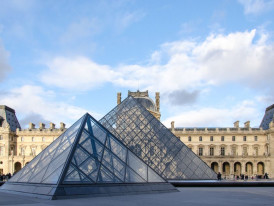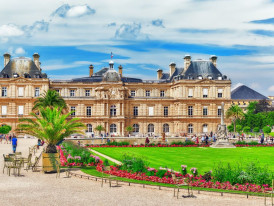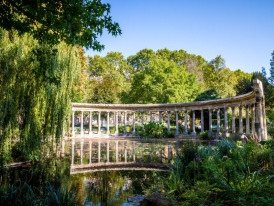
History of Paris
The oldest evidence of human settlement in the territory of today's Paris dates back to the 4th and 3rd millennia BC. Between 250 and 225 BC, the Parisii, a subtribe of the Celtic Senones, settled on the banks of the Seine, built bridges and a fort, minted coins, and began trading with other riverine settlements in Europe.
In 52 BC, a Roman army led by Titus Labienus defeated the Parisii and founded a Gallo-Roman garrison town called Lutetia In 308, the name Paris appears for the first time.

Paris
The town was Christianized in the 3rd century AD and after the fall of the Roman Empire, it was occupied by Clovis I, King of the Franks, who made it his capital in 508. In 508, on behalf of Clovis, Paris became the capital of the Frankish Empire. Around the year 540, Saint-Étienne Cathedral was built on Cité Island, which was later replaced by Notre-Dame Cathedral.
During the Carolingians' rule in the 9th century, Paris was repeatedly burned. King Philip II August was responsible for the boom of Paris. He had massive city walls built. Also the reign of Louis IX. meant changes for Paris. In 1248, Sainte Chapelle was consecrated. In 1250, the Cura Regis, i.e. the Paris Parliament, was established.
After the winter of 1325 to 1326, a flood demolished all the bridges on Cité Island. Between 1348 and 1350, a plague epidemic called the Black Death hit the city, killing roughly a quarter of the population. In the second half of the 14th century, plague epidemics plagued the city of Paris again. As a result of epidemics, stagnation broke out in the development of the city. It lasted until the middle of the 15th century.

Notre-Dame Cathedral
In the Middle Ages, Paris was the largest city in Europe, an important religious and commercial center, and the cradle of Gothic architecture. The University of Paris on the Left Bank, organized in the mid-13th century, was one of the first in Europe. later the city suffered from the bubonic plague in the 14th century and the Hundred Years' War in the 15th century, when the plague repeated. Between 1418 and 1436, the city was occupied by Burgundy and English soldiers.
King Francis I brought a significant development of the country's art and culture. He also bought the creations of Italian artists such as Michelangelo, Titian, and Raphael and thus laid the foundation for the royal picture collection, which is currently on display in the Louvre. His most important building project was the enlargement of the Fontainebleau Castle located near Paris. He also founded the Collège de France in Paris in 1530.

The Louvre
In the 16th century, Paris became the capital of book publishing in Europe, although it was shaken by the French religious wars between Catholics and Protestants.
In the course of the reign of Louis XIII, the economic development of the city took place. In addition to the Marais district, the suburbs of Saint-Honoré and Saint-Germain also developed. Through this period, buildings such as the Luxembourg Palace built for Maria Medici, the Val-de-Grâce monastery founded by Queen Anne of Austria, and the Palais Royal for Cardinal Richelieu were completed.

Luxembourg Palace
Paris was a center of intellectual ferment in the 18th century known as the Enlightenment and the main stage of the French Revolution of 1789, which is commemorated every year on July 14 with a military parade. In the 19th century, Napoleon decorated the city with monuments to military glory. It became the European capital of fashion and the scene of two more revolutions (in 1830 and 1848).
In 1837, the first railway line from Paris to Saint-Germain-en-Laye was opened.
Napoleon III decided to rebuild the capital during his reign to emphasize industrial and social growth. The most important places include the Boulogne and Vincennes forests, Parc Monceau, Parc Montsouris, and Parc des Buttes-Chaumont.

Parc Monceau
Under Napoleon III. and his prefect on the Seine, Georges-Eugène Haussmann, the center of Paris was rebuilt between 1852 and 1870 with wide new avenues, squares, and new parks, and the city was expanded to its present boundaries in 1860. part of the century, millions of tourists came to see the Paris International Exhibitions and the new Eiffel Tower.
Paris experienced development between 1871 and 1914. In January 1887, the construction of the Eiffel Tower began, and on December 28, 1895, the first public screening of the Lumière brothers' film took place at the Grand Café.

Eiffel Tower
In the 20th century, Paris suffered bombing in World War I and German occupation from 1940 to 1944 in World War II. Between the two wars, Paris was the capital of modern art and a magnet for intellectuals, writers, and artists from around the world. The population reached its all-time high of 2.1 million in 1921 but declined for the rest of the century. New museums were opened (Center Pompidou, Musée Marmottan Monet, and Musée d'Orsay) and the Louvre was given a glass pyramid.
The second half of the 20th century marked construction development. In May 1968 there was a student uprising and strike. The result was the division of the University of Paris into 13 separate universities.

Musée d'Orsay
In Paris, the tradition of building pompous and generous buildings continues until the present day. In the 1970s, under President Georges Pompidou, the market hall in the middle of the city was demolished, which, together with the entire set of partly medieval buildings, had to give way to a new cultural center, named after the President Center Pompidou.
At the same time, under the leadership of the Paris City Hall, far-reaching sanitation measures began to be enforced, the result of which was the creation of new, large residential, administrative, and entertainment complexes on the outskirts of Paris.

